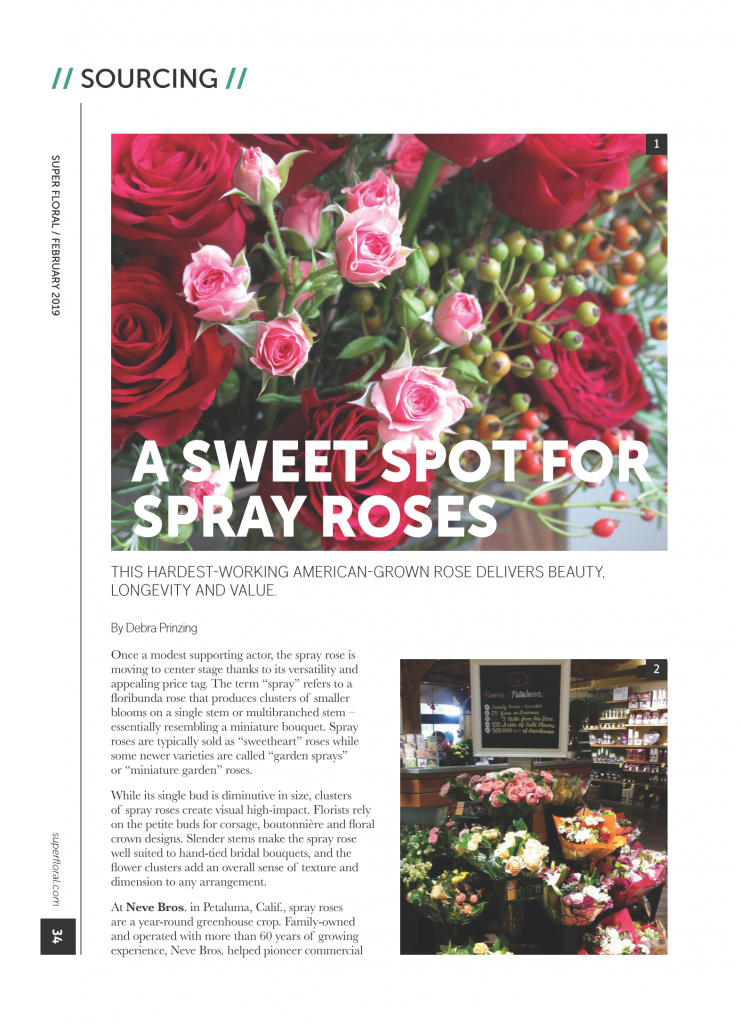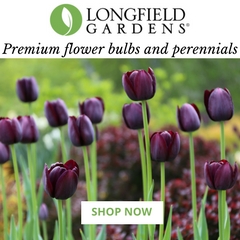Hard-working American-grown roses deliver beauty, longevity and value
Originally published in SuperFloral, February 2019 issue
 Once a modest supporting actor, the spray rose is moving to center stage thanks to its versatility and appealing price tag. The term “spray” refers to a floribunda rose that produces clusters of smaller blooms on a single stem or multi-branched stem – essentially resembling a miniature bouquet. Spray roses are typically sold as “sweetheart” roses, while some newer varieties are called “garden sprays” or “miniature garden” roses.
Once a modest supporting actor, the spray rose is moving to center stage thanks to its versatility and appealing price tag. The term “spray” refers to a floribunda rose that produces clusters of smaller blooms on a single stem or multi-branched stem – essentially resembling a miniature bouquet. Spray roses are typically sold as “sweetheart” roses, while some newer varieties are called “garden sprays” or “miniature garden” roses.
While its single bud is diminutive in size, clusters of spray roses create visual high-impact. Florists rely on the petite buds for corsage, boutonniere and floral crown designs. Slender stems make the spray rose well suited to hand-tied bridal bouquets and the flower clusters add an overall sense of texture and dimension to any arrangement.
At Neve Bros. in Petaluma, Calif., spray roses are a year-round greenhouse crop. Family-owned and operated with more than 60 years of growing experience, Neve Bros. helped pioneer commercial hydroponic rose growing. More than 450,000 square feet of greenhouses, with climate- and feed-controlled systems produce vigorous, healthy plants.
According to co-owner Chris Neve, “the breeding of spray roses has become more refined” in recent years. “The flowers are often larger. There are more flowers per stem. The stems are longer.”
He cites variety in petal colors and bud shapes as top-selling characteristics. “We probably sell as many spray roses as we do hybrid tea roses. If you want to get away from the big classic rose, use the garden spray rose. They’re a perfect accent to different foliages and textures and they work seamlessly in designs when you don’t want to feature a big, bulky rose.”
Neve Bros. supplies Bay Area and Northern California florists and wedding and event designers with a steady harvest of roses. The grower also supplies local independent grocery chains, including Nugget Markets (Woodland, Calif.) and Good Earth Natural Foods (Fairfax, Calif.), with sleeved bunches featuring Neve Roses branding, including the geographic identifier, “Sonoma County.”
“We see what our florists like and we’re able to apply that knowledge to what we offer to grocery stores,” Neve says. “Our niche is a little more stylish, a bit avant-garde.”
Neve’s spray roses are a hit with shoppers, say Karen Rossi, Good Earth Natural Foods’ floral buyer and manager. “We carry spray roses on a regular basis. In fact, we have customers who come in specifically – all year round – for the spray roses.”
The bestselling flower checks a number of boxes, she continues: “They come in at a great price point. They look wonderful. They have a nice shelf life and they are available in beautiful colors.”
 Click here to download a free PDF of the article: Spray Roses
Click here to download a free PDF of the article: Spray Roses
Good Earth Natural Foods has a brand commitment to organic products. For floral, that goal is achieved with locally-grown crops, Rossi says. “Up to ninety-five percent of our product is procured from California flower farms and we source all of our roses from Neve Bros. because they are local. We have a large sign right in front of our floral departments that reads: ‘California Grown.’”
Good Earth Natural Foods offers everyday pricing of $9.99 for a five-stem bunch of spray roses. “We also feature spray roses in mixed bouquets and vase arrangements,” Rossi says. “It’s a flower that both male and female customers love and recognize. In fact, it’s kind of a unisex flower. We have a ton of gentlemen who come in specifically to buy for themselves.”
Most domestic commercial rose growers are based in California (Neve estimates there are eight producers in the state, down from a one-time high of more than thirty). In the Pacific Northwest, Peterkort Roses, a third-generation Oregon farm, is the floral market’s go-to source for greenhouse-grown roses. Plymouth, Minn.-based Len Busch Roses supplies florists and the mass market in Minnesota, Iowa, North Dakota, South Dakota, Wisconsin, Nebraska and Montana.
Founded in 1965, Len Busch Roses maintains 15 acres of cut flowers and flowering plant production under glass. According to Jason Lenz, director of business development, Len Busch Roses currently produces 12 varieties of spray roses and harvests about 6,000 stems of spray roses each week. With an emphasis on local messaging, the growers’ sleeves feature this tagline: “Minnesota Grown. Wildly Fragrant.”
Minnesota-grown is a strong selling point for floral consumers, says Rob Carry, floral and gifts director for Minneapolis-based Kowalski’s Markets, with 11 stores in the Twin Cities.
“Our mission is ‘quality’ first and ‘local’ second – and in dealing with Len Busch Roses we’re lucky to get both of those attributes,” Carry says. “When customers see the Minnesota-grown packaging, it sends a great message.”
Traditional, long-stemmed roses are still in demand, although, “there’s definitely a market for spray roses,” he explains. “Our designers use a lot of spray roses. The product is great, long-lasting and fresh. Seeing the local labeling means two things. It means you’re supporting the local economy, as well as getting the freshest product available.”
Kowalski’s generally offers six stem-bunches of spray roses with everyday pricing of $9.99. “We often reduce the price to $8.99 per bunch to stay competitive,” Carry says. “We’re don’t carry the least expensive flowers on the market, but we have the highest quality. We try to balance that out by having a great consumer-ready product at a great price. Plus, they’re local roses. That local stamp really drives sales for us.”
Lenz believes spray roses are ideally suited for the current “garden-inspired” floral aesthetic. “They’re fitting in with the design work we’re seeing. There are also a lot of new spray varieties in different shades, including pale pink, peach and light lavender.”
Bud count adds up to longevity in the vase and overall perception of value, he adds. “We’re seeing five to ten buds per stem, so when you put that into a sleeve of four stems, you’re definitely getting bang for your buck.”
Care and Handling of Spray Roses
- Prepare a clean vase of water with preservative solution.
- Remove any foliage that will be under water once arranged.
- Cut one inch off each stem and immediately place in vase.
- Check your vase daily and add preservative solution as needed.
- Flowers should be kept out of direct sunlight as the leaves will wilt quicker and lose their color.
Source: Len Busch Roses
Details:
Neve Bros.: nevebros.com, @nevefarms
Good Earth Natural Foods: genatural.com, @goodearthnatural
Len Busch Roses: lenbuschroses.com, @lenbuschroses
Kowalski’s Markets: kowalskis.com, @kowalskis_markets

